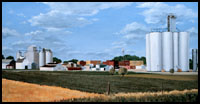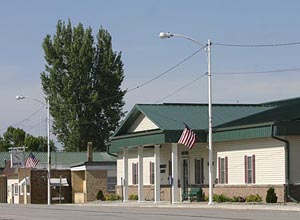The Rolfe Public Library Engages in Digitizing Local History Resources
May 4, 2010
printer-friendly PDF versionThe
Rolfe
Public Library is
nearing completion of a project to digitize 110 oral history interviews
it conducted in 1980 and 1981 with a variety of Rolfe people. The interviews
were recorded on audio cassette tapes but will be available on CDs at
the library. Interested persons can also arrange to obtain CDs for their
own collections.
Recently, the library embarked on a project to digitize 33 rolls of
microfilm of the Rolfe Arrow and related newspapers, such as the
Rolfe Reveille, with publication dates ranging from 1888 to 1989.
The goal is that, by February 2011, the digital version of the newspaper
would be posted on-line where visitors will be able to use the Web site’s search
tool to find key words.
To see an example of how an on-line version can be used, visit the
Web site for the
Laurens Public Library. It is probably best to use Internet Explorer.
Getting Started
The first step for the Rolfe library is to raise funds to pay
Heritage Microfilm of
Cedar Rapids to digitize the Rolfe microfilms and post them on the
Internet. Jeff Brown of Heritage said today that his company has been in
existence since at least the 1970s—if not before. Originally, it was
known as Crest Microfilm but took on the new name in 1996. It is the same
company that originally
microfilmed the Rolfe Arrow and has fresh rolls of the microfilm
in its vault. The company is also connected with the on-line
National Newspaper Archive.
Jeff claims that Heritage is one of only a few companies in the
country that does this kind of work and has an exclusive contract with
the State Historical Society of
Iowa to do its microfilming.
Putting Microfilm in Perspective
Mary Bennett, Special Collections Coordinator at the State
Historical Soceity, said last
week, "In 1976, Iowa was the first in the nation to conduct a
statewide, pilot program to identify and microfilm newspapers under the
auspices of the U.S. Newspaper Project. Using federal funds and local
dollars, the Society and community groups looked through places such as
barns and attics to collect old
newspapers. The Society also created and tested a model for microfilming
those newspapers."
The community that participated in the program and the SHSI both
received a set of microfilm.
Mary put things in perspective, "Microfilm in a 35mm format has
been in existence since 1935, when the National Archives under FDR
developed this time-tested preservation method."
She added that in the last five or six years, there has been a new wave
of interest in microfilm with today's technology making it possible to
digitize microfilm, make PDF files, and post them on-line with the
capacity to do keyword searches. However, she cautioned, “digital is
volatile—always changing, and microfilm is still the preferred way to
copy and archive documents.” In future years, even if there is little
electricity or our 21st Century computer files can no longer be read,
researchers will still be able to view the film, using sunlight.
“On the other hand,” Mary said, “the digital Newspaper Archive is a
terrific research tool."
Mary did not know the history behind microfilming the Rolfe newspapers
but suggested that Delpha Musgrave, coordinator of Local Government
Records and
Newspapers, at the Des Moines offices of the SHSI would know more.
Preserving and Making Iowa Newspapers Accessible
In a phone conversation today, Delpha said, “Part of the mission of the
State Historical Society is to collect, preserve, and make accessible
sources of local history.” She explained that newspapers are points of
Iowa history, and although not required by law, the SHSI asks publishers
to send copies to her office.
The Society has been microfilming newspapers since the mid-1960s. The Rolfe newspapers were initially filmed in 1973 and 1974 at the SHSI,
which already housed copies of them. The work was part of a larger
project funded by a grant from the Library of Congress. Some of the
funds were used to employ staff to work with community volunteers to
find additional newspapers to flesh out the SHSI collection.
The Society's focus then was to film as many newspapers as possible that were
published before 1921.The SHSI concentrated first on its own collection,
completed some of its runs, then added other papers to the project. That
meant the bulk of the Rolfe newspapers in the Rolfe library's
current digitizing project (published 1888–1989) had been microfilmed
prior to Iowa’s pilot project for the U.S. Newspaper Project that began
in 1976.
Delpha said that the Pocahontas Record-Democrat, which bought the
Rolfe Arrow several years ago, regularly sends her its publications.
She logs them in, and they are accessible to the public for a period of
about six months until she prepares them to be microfilmed. That means
she pulls them off the shelf, makes sure there is a complete collection,
prepares “flash” sheets to identify the papers, then wraps and stores
them until she is able to send them to be microfilmed at Heritage
Microfilm.
Delpha reported, though, that the SHSI has limited funding and a backlog of newspapers waiting
to be filmed. In fact, in the current fiscal
year, there is no money in the SHSI budget to continue the microfilming.
It is common knowledge among people who know much about the SHSI that
the organization has been under duress for a number of years. The
current slump in the state’s economy exacerbates an already difficult
situation.
Delpha said that National Endowment for the Humanities currently has funds that
can be used for further microfilming, but the SHSI has no grant-writing
staff person to apply for those funds. Otherwise, the SHSI could get
help through an extension of its original project of microfilming
newspapers prints prior to 1921.
The Background on Rolfe Projects
The era of the late 1970s and early 1980s was when the Rolfe library
sowed the seeds for and conducted its oral history project. It would be
interesting to explore the history of how the library raised the funds
for and conducted both the microfilming project and the oral history
project.
The late Marion Gunderson, who was married to Deane Gunderson (RHS
1935), served as the director of the Rolfe library during that time and
a driving force on these kinds of local history projects. The youngest
of their six offspring,
Louise Gunderson Shimon (RHS 1973), who lives near Perry and has exhibited
a strong identification with her mother and a
zeal for extending Marion's legacy, is the driving force behind
migrating the audio cassettes and microfilm rolls to digital formats.
Roy Koepke, a member of the Rolfe library board of directors, says that
Louise has met several times with the board about the projects, but the
board is taking a passive role—letting Louise be the active agent. Lori
Pedersen, the board secretary, says that Louise has been asked to clear
any steps she takes with the board. Penny
Tilden, current director of the library, says, “The microfilm
project is Louise’s brainstorm. The staff members have busy lives, the
board doesn't want to get into it, and we are fine with her running the
show.”
Converting the audio cassettes to digital format was also Louise’s idea,
and funds that she and the library raised were used to pay Mike
Majorowicz (RHS 1983) of Wild
Faces Gallery and Frame
in Rolfe to provide the technical services.
Donating to the Rolfe Newspaper Project
Persons who wish to contribute funds for the microfilm project can give
cash or send a check payable to “Rolfe Public Library Trust” and write
“newspaper project” in the memo area or on an attached page. The
donation can be delivered in person or mailed to Rolfe Public Library,
317 Garfield Street, Rolfe, Iowa, 50581. The fund is administered by the
City of Rolfe, which has arranged for official 501 (c)(3) non-profit
status for the trust, meaning that donations are tax deductible.
It is important that the word “trust” be included in writing the check.
Presumably, the donation could otherwise be deposited in the library’s
general fund where it could be channeled to other uses or revert to the
city if not used by the end of its fiscal year.
When making a contribution, please attach a page, telling the:
- Name/s of the donor/s.
- Amount of donation payable to the Rolfe Public Library Trust.
- Whether you would like to sponsor the digitizing of an entire
microfilm roll for $115 and the time period you wish to sponsor.
- And if you wish to be contacted when the newspapers are
available on-line, contact information, including email address,
phone number, and mailing address.
There are probably ways that concerned people can also give to the
State Historical Society to help it preserve recent newspapers on
microfilm.
Other On-Line Rolfe History Projects
Related Rolfe research resources are already on the Internet. Check
out the index to
the Rolfe cemeteries. Apparently, Jim Hansen (DMT class of 1956). and
Sharalyn Wolfe Hansen (RHS 1963), walked the cemeteries and recorded
information, then had Marion Gunderson enter the data into digital
format, then arranged to have it posted on-line.
Also, take a look at the materials from
time capsules
that the classes of 1917 and 1928 left at the Rolfe school. Our Web site
editor, Helen Gunderson (RHS 1963), who another of the Gunderson
siblings, voluntarily digitized and posted all the items. Helen has also
done many other local history projects for this site, other groups, and independently.
She gave DVDs with high resolution files of the capsule items to
Superintendent Joseph Kramer of the Pocahontas Area School District.
Apparently, the time capsules and contacts are still stored in the vault
near his office. A few years ago, he agreed have the district make copies of the DVDs and give a
set to the Rolfe library, Pocahontas library, and the PAC library.
However, he has not confirmed that he has done so, nor has he responded
to efforts to contact him to clarify the status of the DVDs.
|

